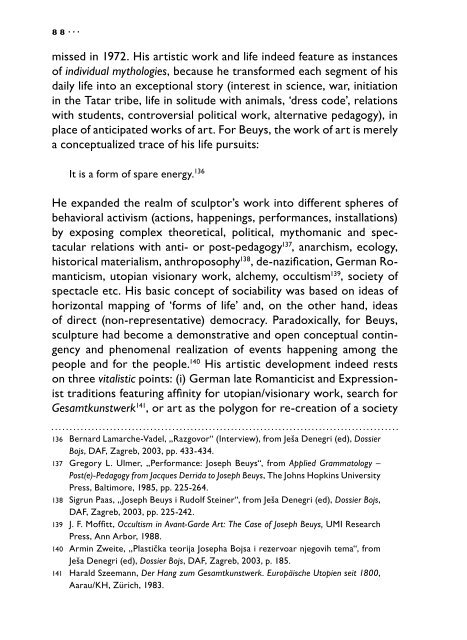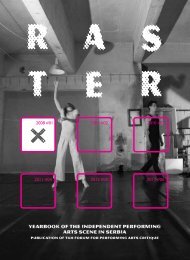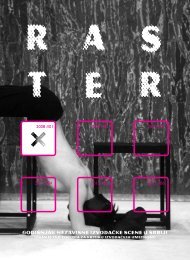Miško Šuvaković Epistemology of Art - TkH
Miško Šuvaković Epistemology of Art - TkH
Miško Šuvaković Epistemology of Art - TkH
You also want an ePaper? Increase the reach of your titles
YUMPU automatically turns print PDFs into web optimized ePapers that Google loves.
88··· ··· 89<br />
missed in 1972. His artistic work and life indeed feature as instances<br />
<strong>of</strong> individual mythologies, because he transformed each segment <strong>of</strong> his<br />
daily life into an exceptional story (interest in science, war, initiation<br />
in the Tatar tribe, life in solitude with animals, ‘dress code’, relations<br />
with students, controversial political work, alternative pedagogy), in<br />
place <strong>of</strong> anticipated works <strong>of</strong> art. For Beuys, the work <strong>of</strong> art is merely<br />
a conceptualized trace <strong>of</strong> his life pursuits:<br />
It is a form <strong>of</strong> spare energy. 136<br />
He expanded the realm <strong>of</strong> sculptor’s work into different spheres <strong>of</strong><br />
behavioral activism (actions, happenings, performances, installations)<br />
by exposing complex theoretical, political, mythomanic and spectacular<br />
relations with anti- or post-pedagogy 137 , anarchism, ecology,<br />
historical materialism, anthroposophy 138 , de-nazification, German Romanticism,<br />
utopian visionary work, alchemy, occultism 139 , society <strong>of</strong><br />
spectacle etc. His basic concept <strong>of</strong> sociability was based on ideas <strong>of</strong><br />
horizontal mapping <strong>of</strong> ‘forms <strong>of</strong> life’ and, on the other hand, ideas<br />
<strong>of</strong> direct (non-representative) democracy. Paradoxically, for Beuys,<br />
sculpture had become a demonstrative and open conceptual contingency<br />
and phenomenal realization <strong>of</strong> events happening among the<br />
people and for the people. 140 His artistic development indeed rests<br />
on three vitalistic points: (i) German late Romanticist and Expressionist<br />
traditions featuring affinity for utopian/visionary work, search for<br />
Gesamtkunstwerk 141 , or art as the polygon for re-creation <strong>of</strong> a society<br />
136 Bernard Lamarche-Vadel, „Razgovor“ (Interview), from Ješa Denegri (ed), Dossier<br />
Bojs, DAF, Zagreb, 2003, pp. 433-434.<br />
137 Gregory L. Ulmer, „Performance: Joseph Beuys“, from Applied Grammatology –<br />
Post(e)-Pedagogy from Jacques Derrida to Joseph Beuys, The Johns Hopkins University<br />
Press, Baltimore, 1985, pp. 225-264.<br />
138 Sigrun Paas, „Joseph Beuys i Rudolf Steiner“, from Ješa Denegri (ed), Dossier Bojs,<br />
DAF, Zagreb, 2003, pp. 225-242.<br />
139 J. F. M<strong>of</strong>fitt, Occultism in Avant-Garde <strong>Art</strong>: The Case <strong>of</strong> Joseph Beuys, UMI Research<br />
Press, Ann Arbor, 1988.<br />
140 Armin Zweite, „Plastička teorija Josepha Bojsa i rezervoar njegovih tema“, from<br />
Ješa Denegri (ed), Dossier Bojs, DAF, Zagreb, 2003, p. 185.<br />
141 Harald Szeemann, Der Hang zum Gesamtkunstwerk. Europäische Utopien seit 1800,<br />
Aarau/KH, Zürich, 1983.<br />
and its traumas, (ii) international fluxus and, consequently, multimedial<br />
opening <strong>of</strong> the work to hybrid situations and events, and (iii)<br />
European conceptual art as an attempt at post-symbolic re-creation<br />
<strong>of</strong> metaphysical events in the art world. His pedagogic work was vitalist<br />
and activist, being based upon the mythical-messianic concept <strong>of</strong><br />
designing and shaping individual and social life through direct interpersonal<br />
exchange. His pedagogy abounded in contradictions because<br />
he plainly confronted creative attitude <strong>of</strong> a charismatic pr<strong>of</strong>essor with<br />
demands for direct democracy – decision-making in art and political<br />
activity. Nevertheless, he perceived the very work <strong>of</strong> art as a mode<br />
<strong>of</strong> social-political action and interests pertaining to the contemporary<br />
capitalist world. Beuys implemented his activist ideas oscillating between<br />
high/elite and alternative art:<br />
It could be said that this is the theory <strong>of</strong> work: each work has a sort<br />
<strong>of</strong> relation towards the art, and the art does not represent any more<br />
a type <strong>of</strong> isolated action or gathering with people capable to do the<br />
art while the others must do something else. That is exactly the aim<br />
<strong>of</strong> my effort. 142<br />
At the same time, Beuys’ work from the period between the last utopian<br />
neo- and post-avantgardes and the rising postmodern, assumes a<br />
character <strong>of</strong> spectacle. He introduced organic processuality <strong>of</strong> matter<br />
or being to mass-media spectacle: by way <strong>of</strong> a gesture apparently shamanistic,<br />
indeed the shaman is de-realized. Nevertheless, the artistic<br />
super star is born. His teaching at the Düsseldorf Academy was set<br />
in a spectacular manner, i.e. so that effects <strong>of</strong> charismatic actions on<br />
the part <strong>of</strong> the pr<strong>of</strong>essor and critical democratic political work on<br />
the part <strong>of</strong> his students become a demonstration, visible and manifest.<br />
Contradictory spectacular relationship between the charismatic<br />
teacher and his activist-leaning students was not a simple confrontation<br />
and paradox, but a form <strong>of</strong> social practice <strong>of</strong> seduction wherein<br />
‘learning’ took place as a concurrent process <strong>of</strong> seduction (fatal proximity<br />
<strong>of</strong> object and subject) and demystification (critique <strong>of</strong> the fateful<br />
confusion between objects and subjects <strong>of</strong> art, or politics).<br />
142 Bernard Lamarche-Vadel, „Razgovor“ (Interview), from Ješa Denegri (ed), Dossier<br />
Bojs, DAF, Zagreb, 2003, p. 433.







